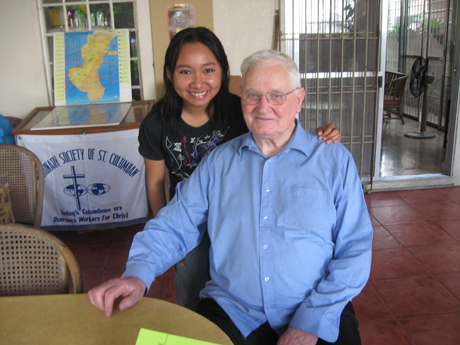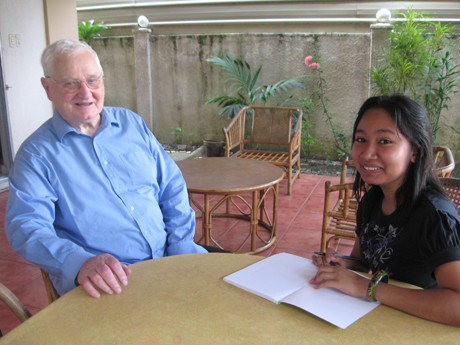His Home In Negros
By Richelle H. Verdeprado
Born in Omagh, Northern Ireland on 15 December 1926, Fr Terence Bennett or ‘Father Terry’ has spent most of his life as a Columban missionary priest in Negros, Philippines. This morning, eight days before he celebrates his 84th birthday and three days before he returns to Ireland, I’m happy to be given this opportunity to interview him. Father Seán had introduced us to each other several times already, perhaps because we kept forgetting each other. But after this one-hour interview, I’m sure we won’t be forgetting each other anymore.

Father Terry was the eldest of seven children. The idea of becoming a priest came to him through the first cousin of his mother, Fr Thomas ‘Tommie’ McGovern, who was a Columban priest, prayed for him that he would enter the seminary and it happened. Father Terry joined the Columbans at the age of 17. Father Tommie also prayed for his younger brother Donal and the same thing happened.
Father Terry’s first assignment after he was ordained in December 1950 was the Philippines. He arrived in Manila on 21 November 1951 and then moved to Isabela, Negros Occidental, on his birthday. When he arrived in Negros, the parishioners had prepared a despedida party for Fr Michael Cullen and a bienvenida party for him. It was a fun celebration and it gave Father Terry a very positive impression of Negrosanons and Filipinos.
Father Terry stayed in Isabela for only three months. There was a need for a chaplain in St Paul’s College, Dumaguete City, Negros Oriental, and so he was immediately sent there. After almost three years, he returned to Negros Occidental and was assigned to several parishes such as Kabankalan, Moises Padilla and Sipalay. He learned Hiligaynon (Ilonggo), the language spoken in most of Negros Occidental, and loved doing so. One thing that amazed him was that people were very patient with him while he was learning the language. Back then, only a few in the community could speak and understand English. He had to use Hiligaynon in the Mass and because he wasn’t confident of saying what he meant to say, he would only give short sermons. That was the reason why Father Terry really exerted efforts in practicing the language.
After seven years in Negros, Father Terry returned to Ireland for a vacation and when he came back to the Philippines he was assigned to Student Catholic Action (SCA) in Manila. Members would meet at weekends in small groups to discuss a passage from the Bible, to share their personal reflections and to help each other strengthen their relationship with God. They also developed potential leaders from the group. Father Terry then recalled that the SCA was discouraged by the government during Martial Law and even banned along with other student organizations. Despite this, members remained steadfast in their commitment. Never did he think that what started as a gathering of a few students would later expand throughout the country.

After serving selflessly in Manila, Father Terry was reassigned to Negros. It was in Negros where he dedicated most of his time and energy as a priest. It was in Negros where he encountered people traveling endlessly as he witnessed daily the great number of passengers on busses and jeepneys throughout Negros. It was in Negros where he experienced his most difficult moment which turned out to be the most memorable one.
This life-testing event happened in 1978 in Sipalay, in the southern part of Negros Occidental. There was a rally against soldiers who had been violating the rights of the people and contributing to the terror in the area. The priests had a meeting first and designated tasks for the rally even though Bishop Antonio Y. Fortich advised against it. There was great pressure from the local government yet despite the fear they felt within, what was the most important for the priests and people during that time was to fight injustice.
The speaker before Father Terry had caused intense reaction among the people. Father Terry was really worried that the rally might turn violent and so to keep the rally peaceful, he felt that it was his role to calm everyone. And so he did! He even sang and danced in front of the crowd to change the atmosphere inside the church compound. As they struggled together against injustice, they ended their rally with a song Father Terry will never forget. With joyful hearts and unwavering hope, they sang Ang Kalipay sang Ginuo Amo ang Aton Kusog (‘The Joy of the Lord is our Strength’).
Negros will always be a home for Father Terry even though he is now living in his native land. Filipinos will always be a family for him and those who are blessed to know him will certainly not forget him. How could we forget a man who has shown concern about the social realities affecting us? How could we forget such a humble priest who can understand what the people feel? There will always be this connection of feelings that will bridge the people of the Philippines and Father Terry in Ireland. This connection is that kind which will inspire us to pray for each other and to sing out loud that the joy of our Lord is our strength.
You may email the author at rich_verde706@yahoo.com.ph
